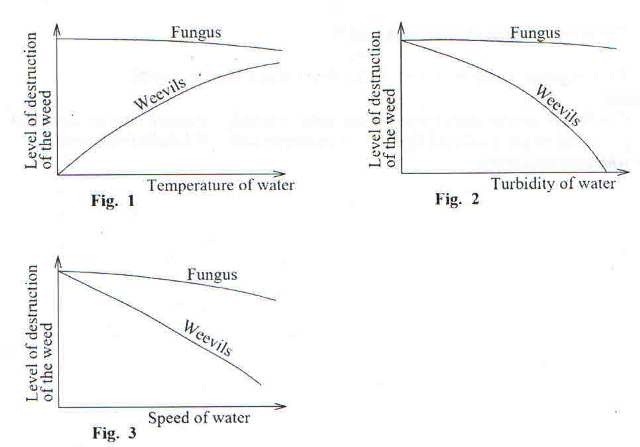1. a) Describe the different mechanisms employed by mammals to increase their chances of fertilization and survival.
b) How does territorial behavior contribute to the evolutionary success of species?
2. a) What are the problems of large size in animals?
b) Explain how the problems of large size in animals have been overcome.
3. The water hyacinth Eichhornia crassipes is a weed growing on many waters of Uganda. In the biological control of the weed on Lake Victoria, a fungal pathogen and weevils are employed.
The characteristics of the fungus and the weevils in relation to their feeding behavior is shown in Table 1.
Table 1
|
Fungus |
Weevils |
|
Feeds on the water hyacinth alone |
May feed on other plants other than the water hyacinth |
|
Attacks only the green parts of the plant |
Attacks all parts of the plant |
The level of destruction of the weed by the fungus and the weevilsunder varying water conditions in temperature, tubidity and speed of water, are shown in figures 1,2 and 3.
Study the information and answer the questions that follow.

a) From figures 1, 2 and 3 describe the level of destruction of the weed by each of the organisms under different conditions of water.
i) Fungus
ii) Weevils
b) From the information provided, suggest explanations for the level of destruction of the weed by each organism under different conditions of water.
i) Fungus
ii) Weevils
c)From the information provided, give advantages that the
i) fungus has over the weevils in destroying the weed.
ii) weevils have over the fungus in destroying the weed.
d) What are the ecological effects of the water hyacinth on Lake Victoria?
e) What are the advantages of employing biological control as a means of checking the population of the water hyacinth?
4. a) Explain what is meant by dormancy in seeds.
b) Describe the causes of dormancy in seeds.
c) Explain why dormancy is more common in weeds and annual plants than in tropical forest trees.
5. a) Using illustrations, describe the different types of thickening found in the vessels of the xylem.
b) Explain how materials are transported in the xylem.
c) Explain the role of transpiration to flowering plants
6. a) Compare saprophytes with parasites.
b) Outline the economic importance of saprophytes.
c) Describe factors that have led to the success of saprophytes in most terrestrial habitats.
END
